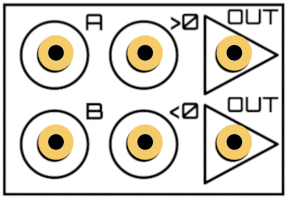Difference between revisions of "Comparator"
(describe how to compare two signals) |
(better formulation, because it doesn't matter which signal is inverted) |
||
| Line 5: | Line 5: | ||
Given two inputs <code>A</code> and <code>B</code>, the comparator tests whether the sum of the two input values is larger or smaller zero. If it is larger, the input <code>>0</code> is directed to <code>OUT</code>, if smaller, the input <code><0</code> is directed to <code>OUT</code>. | Given two inputs <code>A</code> and <code>B</code>, the comparator tests whether the sum of the two input values is larger or smaller zero. If it is larger, the input <code>>0</code> is directed to <code>OUT</code>, if smaller, the input <code><0</code> is directed to <code>OUT</code>. | ||
| − | If you want to compare two signals, you | + | If you want to compare two signals, one of them must be inverted before you connect them to inputs <code>A</code> and <code>B</code>. |
Technically, the comparators of THAT are implemented with Schmitt Triggers and two analog switches. See [[:File:Anathing_v1.0_base_4.pdf]] for the schematics. | Technically, the comparators of THAT are implemented with Schmitt Triggers and two analog switches. See [[:File:Anathing_v1.0_base_4.pdf]] for the schematics. | ||
Latest revision as of 09:10, 27 September 2021
The Comparator is a logic element which puts different signals on the output, depending on the input. The Analog Thing features two comparators.
Given two inputs A and B, the comparator tests whether the sum of the two input values is larger or smaller zero. If it is larger, the input >0 is directed to OUT, if smaller, the input <0 is directed to OUT.
If you want to compare two signals, one of them must be inverted before you connect them to inputs A and B.
Technically, the comparators of THAT are implemented with Schmitt Triggers and two analog switches. See File:Anathing_v1.0_base_4.pdf for the schematics.
The schematic is not incomplete - the input resistor networks are located on the front panel (as for the summers, inverters, and integrators).
